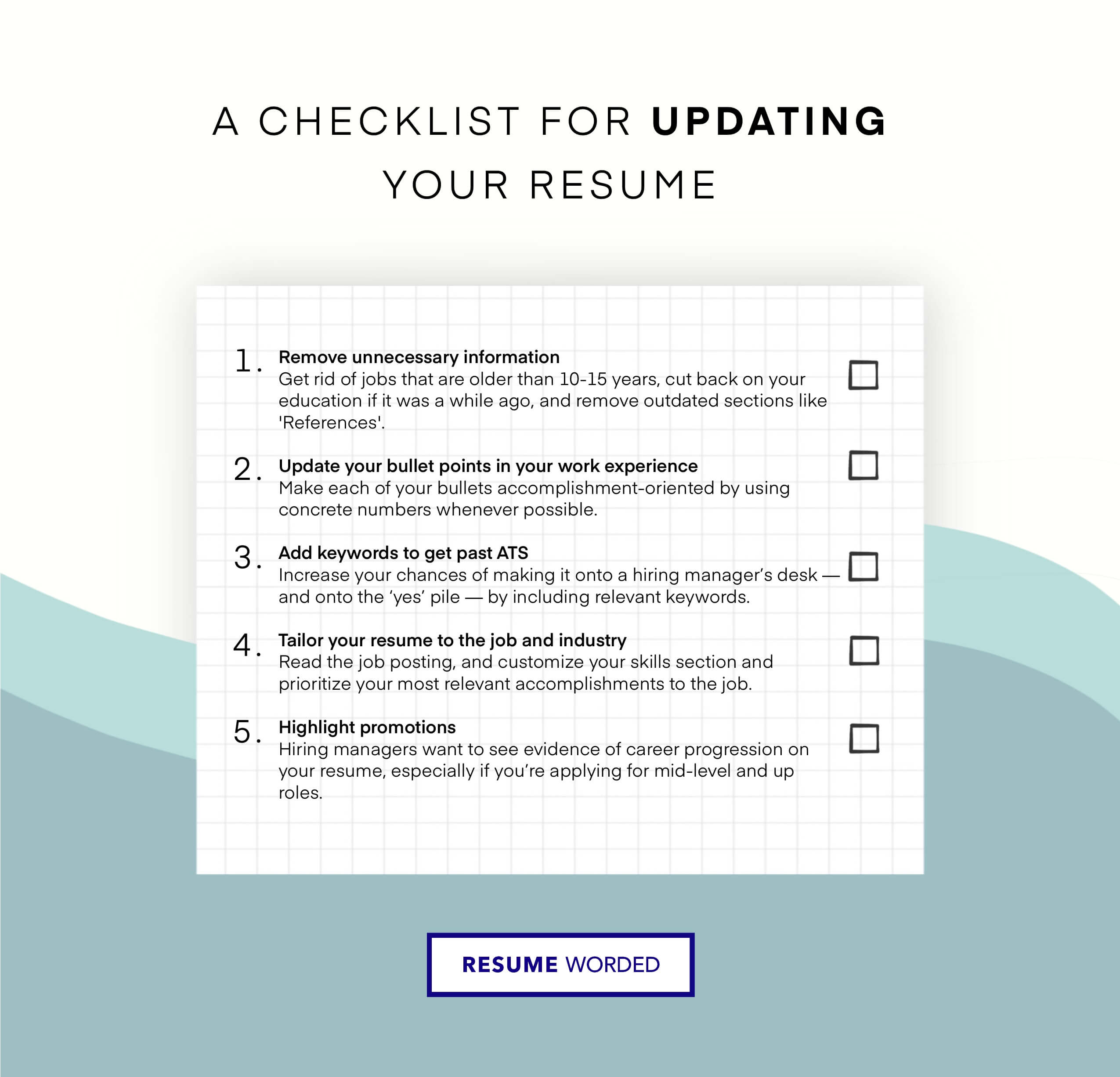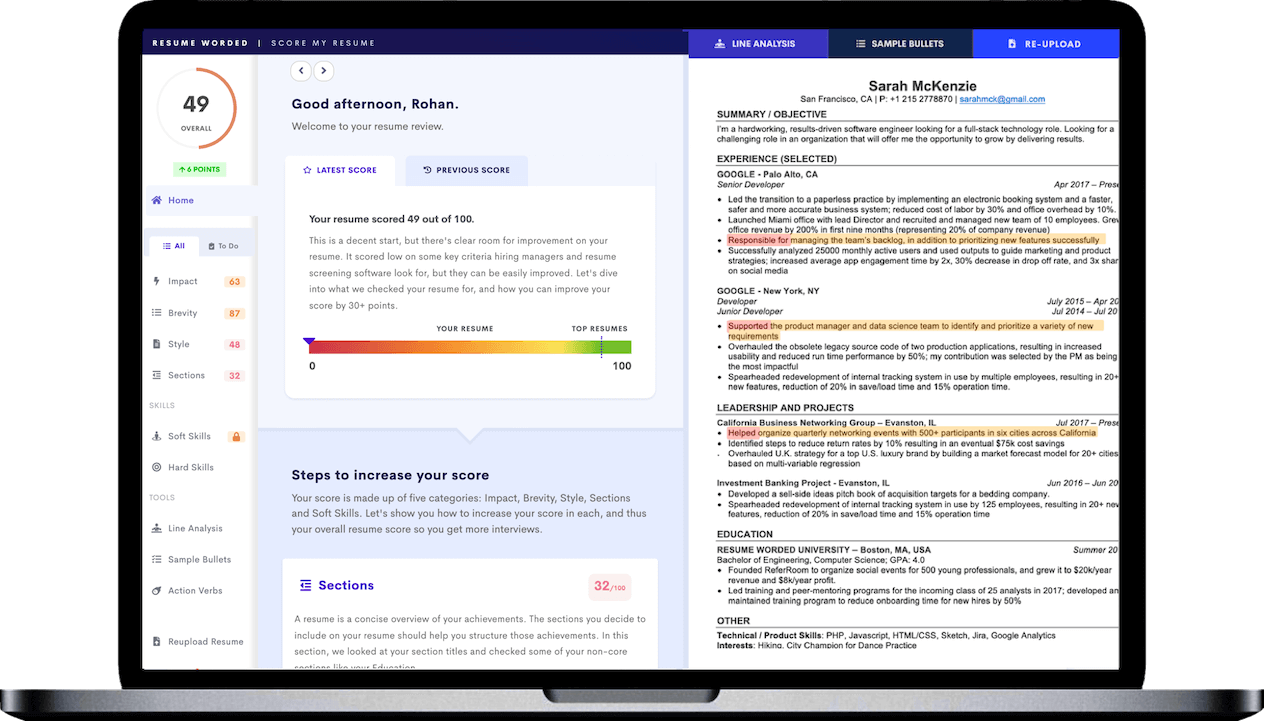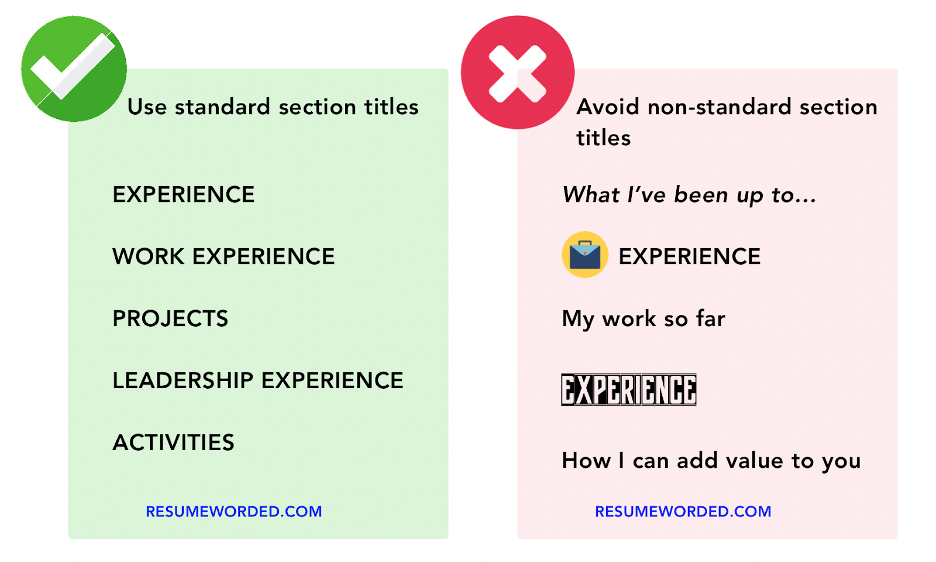The job market is changing more rapidly than ever, which means that resume trends seem to be coming (and going) faster than ever. So, which trends are worth following — and which ones are better off ignored?
We’ve analyzed the current resume trends and landed on 12 resume trends for 2025 that aren’t going anywhere. These are all based on data and backed by recruiters, which means you can bypass the fads and skip straight to the resume tips that’ll actually help you land a job.
Wondering what the best resume tips are for 2025? Here’s a quick overview.
Top 12 resume trends in 2025
In 2025, look out for:
- Sticking with a classic resume format
- Keeping it brief
- Having multiple resumes
- Optimizing your resume with keywords
- Integrating soft skills
- Quantifying your impact with numbers
- Embracing of remote work
- Using AI to help your job search
- ... And leaning into AI-specific skillsets
- Highlighting technical skills
- Addressing the market
- Linking to social media
Let’s take a more in-depth look at each of these trends, including what they mean for you and how to stay ahead of the curve.
Top resume trends for 2025
1. Use a simple chronological resume format
In 2025, we’ve seen a lot of resume trends come and go. Infographics, functional resumes, and online resume builders have all come … and gone. What’s here to stay is the classic, easy to read chronological resume.
When writing a resume, there’s no need to get creative with fonts, images, graphs, tables, or fancy layouts. Instead:
Download a simple ATS-ready resume template
- Stick to default formatting in Google Docs or Microsoft Word
- List your experience in order from most recent to least recent
- Always include your dates of employment
- Use bold, underline, and italics if you need text to stand out
- Export your resume as a PDF to keep your formatting intact
2. Keep your resume short and skimmable
Sometimes, less is more — and that includes on your resume. Most resumes only need to be one page long and include:
Most of that should be in bullet point format, too, which means recruiters can quickly skim your resume — and important information is more likely to stand out.
Related: How Long Should a Resume Be?
3. Have multiple versions of your resume
Think you can write a single, perfect resume that you can use to apply to any job? Think again!
One of the best ways to land a job is to tailor your resume, which means you’ll end up having at least a few different variations of the same resume. This could be as simple as adding a resume title or as in-depth as curating which jobs you list when applying for roles in different industries. You can also get help from tools like Targeted Resume, which will check your resume against the target job description and identify specific ways to tailor your resume to that position.
Related: How To Tailor Your Resume To a Job
4. Bypass ATS with resume keywords
If you’re currently applying for jobs, you’ve probably heard of Applicant Tracking Systems (ATS). These are automated scanners that companies use to screen resumes before they hit the desk of a hiring manager.
ATS search your resume for a set list of keywords, which means they’re pretty easy to bypass. The key is to not overdo it — after all, you don’t want a resume so stuffed full of keywords that it gets rejected by the first person to read it. Instead, use a tool like our skills and keywords finder to search for relevant keywords and scatter them naturally throughout your resume.
Related: How To Beat Applicant Tracking Systems in a Few Easy Steps
5. Highlight transferable skills
These days, nobody expects to stay in the same job for their whole career — the average tenure of a new job is less than five years, which means that the average person will hold around 12 jobs in their lifetime. With that in mind, it makes sense to build your resume around skills that you can take with you — in other words, transferable (or soft) skills.
According to a recent breakdown of job listing, the top soft skills recruiters are looking for include:
- Communication
- Customer service
- Time management and scheduling
- Project management
- Analytical thinking
- Working independently
- Interpersonal skills and collaboration
- Flexibility
- Attention to detail and accuracy
- Multitasking
Related: Here's How To Include Soft Skills on Your Resume
6. Quantify your impact with concrete metrics
The easiest way to show the actual impact you had in a role is to use numbers in your bullet points. This allows hiring managers to get a better feel for how you’re likely to perform in the new role. It’s also a good way to stand out in a sea of applicants, as the vast majority of resumes don’t fully quantify their accomplishments.
Here’s an okay bullet point:
Hired, coached and led sales team.
By adding more details, we can make it better:
Hired, coached and led sales team of five to make sales calls, make client visits and close deals.
And by using metrics to show results, we create an impactful, measurable accomplishment:
Hired, coached and led sales team of five to make sales calls, make client visits and close deals; generated $10M in sales contracts.
Related: How To Quantify Your Resume
7. Get on board with remote work
You don’t have to be looking for remote work to know that it’s everywhere — and you shouldn’t expect this to go away in 2025. Job boards like FlexJobs and Remote OK cater specifically to people looking for remote work, while even the larger job boards have hundreds of thousands of remote jobs listed.
Even if you aren’t working remotely, you’re likely to be dealing with people who are, which means that highlighting experience managing remote workers or your ability to use remote tools like Slack and Zoom is always a plus.
Related: The Complete Guide To Listing Remote Work on a Resume
8. Use AI to your advantage
In 2025, it seems like Artificial Intelligence is everywhere. Employers are obviously using it — but so can job seekers.
AI-powered tools like Score My Resume work in a similar way to ATS, by analyzing your resume and providing actionable steps to improve it. Think of it kind of like a Grammarly for resumes — instead of just fixing your spelling and grammar, it can check for job-specific keywords, resume and bullet point length, inconsistencies, word choice, and any filler or buzzwords you can safely eliminate.
9. Learn to work with AI, too
If you believe the naysayers, AI is about to take over and automate just about every job imaginable. Which may be true ... but in that case, who runs the AI?
The answer is: People do. If AI has started invading your industry, look at expanding your skillset to include AI-specific skills, like AI-assisted coding or ChatGPT prompt writing.
10. Prove that you’re competent with technology
The technology trend doesn't stop with AI. Even in low-tech fields, a little tech savvy goes a long way. Being able to troubleshoot problems and use common technologies can make the difference between hitting the ground running and struggling to keep up.
Looking to make the next move in your career — or to change fields entirely? 2025 is an excellent time to start developing in-demand skills like:
- Search Engine Optimization (SEO)
- Software as a Service (SaaS)
- Cybersecurity
- Data analysis
- Cloud computing
- Blockchain
- Automation
- Artificial intelligence and machine learning
- Augmented reality and virtual reality (AR and VR)
- Digital marketing
- User interface and user experience design (UI and UX)
- Programming languages like HTML, CSS, Java, and SQL
11. Write a market-driven resume
This may sound gimmicky, but all it really means is a) keeping up-to-date with trends in hiring in general and your field in particular, and b) tweaking your resume to address these trends.
If that sounds calculated or impersonal, remember this: Your resume isn't about you, it's about the job you want. Instead of trying to include a complete history of who you are and what you've done, create a resume with a purpose — one that addresses specific needs in your industry or company and explains how you can fill those needs.
12. Update and link your LinkedIn
Whether you’re always on social media or not a huge fan, there’s no doubt that it’s become an important part of job searching. LinkedIn alone is home to over 800 million users, including over 58 million registered companies.
Add a link to your LinkedIn profile, GitHub, or portfolio to the top of your resume (next to your contact details).
A trend we're seeing in 2025: Companies are recruiting more and more via LinkedIn so ATS now provide LinkedIn integrations, where experience can be imported via LinkedIn. So, keep your profile up to date and make sure it reflects skills on your resume.
If your LinkedIn needs a little revamp — or a complete overhaul — LinkedIn Review can provide personalized tips on how to optimize your profile and generate up to five times as many leads.
By the way, it's worth mentioning — keep your other social profiles, like Instagram or Facebook, on private when you're recruiting if you have any content you don't want recruiters seeing.
Related: How To Make Your LinkedIn Stand Out
Resume trends to avoid
Not all trends are created equal — so which ones should you avoid? Here's a list of gimmicks to steer clear of:
- Functional resumes. These are often touted as a way to hide a spotty work history or lack of experience, but in reality, they do the opposite — not listing dates on your resume or using a skills-based format just makes recruiters wonder what you're trying to hide.
- Infographics. These had their moment, but arguably were never a great idea in the first place (for a start, ATS can't read images). Skip the fancy graphics and stick to a classic, text-based resume.
- Resume objectives. This one's so old that some people are trying to make it new again. Resume summaries are different and can actually be useful, but an objective adds nothing to your candidacy. Skip it.
- Gimmicky resumes. It might sound fun to have your resume printed on a beer label, a t-shirt, or a QR code, but the people actually making hiring decisions aren't looking for fun — they're looking for a simple document clearly listing your work experience, skills, and education.
Remember that trends aren't everything — the most important thing when it comes to writing a resume is clearly communicating information. Anything that gets in the way of that is an instant "no."










